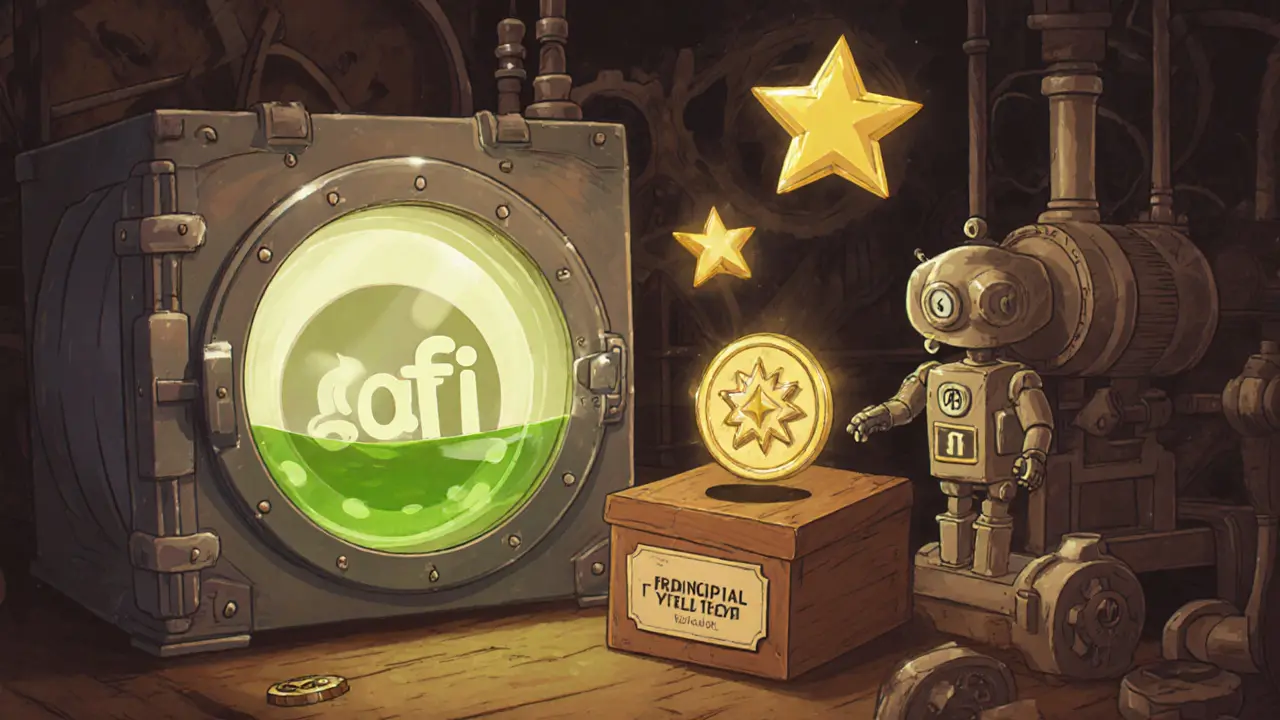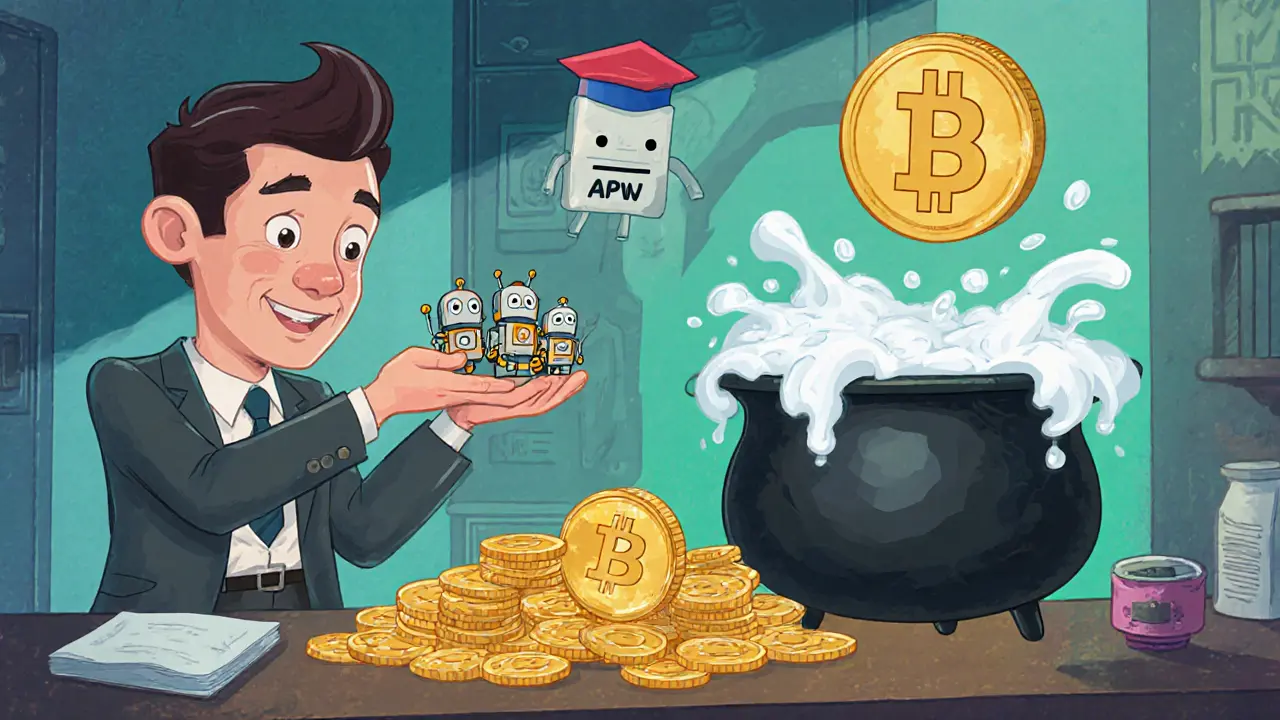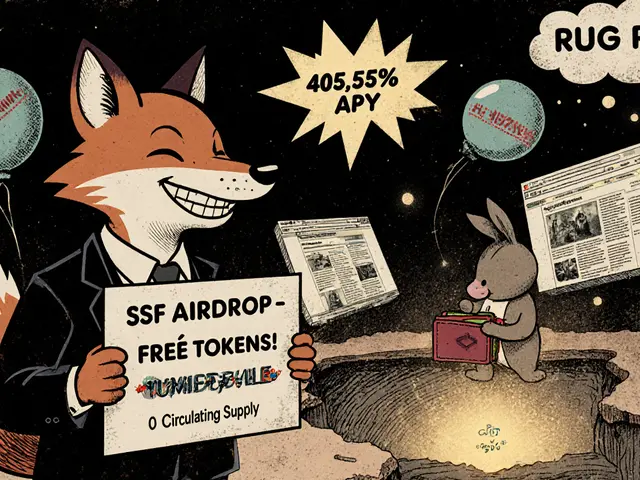
Spectra (APW) Yield Token Calculator
Principal Token (PT)
$0.00
Original capital returned at maturity
Yield Token (YT)
$0.00
Full future interest earned
Future Yield Token (FYT)
$0.00
Immediate cash flow from future yield
How It Works
This calculator demonstrates Spectra's yield tokenization model:
- Principal Token (PT): Represents your original investment which is returned at maturity
- Yield Token (YT): Captures the total future interest earned over the lock-up period
- Future Yield Token (FYT): Splits the yield into time-based chunks that can be sold for immediate liquidity
Adjust the inputs to see how different scenarios affect your potential returns.
Did you know the APW token once surged to $5.82 before plunging below $0.10? That roller‑coaster tells a story about a niche DeFi protocol trying to turn future interest into tradable assets. If you’ve heard the name Spectra (formerly APWine) and wonder what it actually does, you’re in the right place.
What is Spectra and the APW token?
Spectra is a decentralized, permissionless interest‑rate derivatives protocol built on the Ethereum Virtual Machine (EVM). It lets users break future yield into tradeable pieces. The protocol’s native governance token is the APW token the governance token that gives holders voting rights over protocol upgrades, fee parameters, and market creation rules. Holding APW means you can shape how Spectra evolves while earning any future rewards the protocol distributes.
How does yield tokenization work?
The magic behind Spectra lies in three token types that sit on top of standard interest‑bearing tokens (IBTs) like aDAI from Aave.
- Principal Token (PT) represents the original capital you locked into the protocol. You can think of it as the “safe” part that will be returned at maturity.
- Yield Token (YT) captures the whole future interest generated by the locked capital. Holding a YT gives you the right to claim all accrued yield once the term ends.
- Future Yield Token (FYT) splits a YT into precise time chunks - from a single day up to several months. FYTs let you sell a slice of future interest today, turning a future cash‑flow into immediate liquidity.
To start, you deposit an Interest‑Bearing Token (IBT) an ERC‑4626 token that automatically earns yield, such as aDAI or aUSDC into Spectra’s smart contract for a predefined period. The contract mints PTs, YTs, and FYTs according to the duration you chose. FYT holders can trade these on Spectra’s automated market maker (AMM) and receive the yield upfront, while PT holders wait to get their original capital back at the end.

Core use cases
- Fixed‑rate hedging: Traders who dislike variable returns can lock in a guaranteed yield by selling FYTs and receiving cash now.
- Yield speculation: If you think future rates will rise, you can buy FYTs at a discount and claim the higher yield later.
- Liquidity provision: LPs supply both PTs and FYTs to Spectra’s AMM, earning swap fees and a share of protocol revenue.
Each scenario targets a different user segment - from risk‑averse savers to sophisticated yield traders.
How Spectra stacks up against other DeFi yield solutions
| Protocol | Core Focus | Tokenization Approach | Typical Liquidity (24h Vol) | Best For |
|---|---|---|---|---|
| Spectra | Interest‑rate derivatives | Future Yield Tokens (FYT) in granular time slices | $33.85 (APW) | Hedgers and yield speculators |
| Notional Finance | Fixed‑rate loans | Fixed‑rate loan tokens for whole term | ~$2M+ | Borrowers seeking predictable rates |
| Yield Protocol | Fixed‑rate borrowing/lending | Principal‑Yield token split (no granular FYT) | ~$500K | Simple fixed‑rate users |
| Aave | Variable‑rate lending | Standard interest‑bearing tokens (aDAI, aUSDC) | ~$30M | Yield farmers and borrowers comfortable with volatility |
The table shows Spectra’s unique advantage - precise time‑based FYTs - but also highlights its liquidity gap compared with mainstream platforms.
Risks and challenges
- Price volatility: APW’s market price has swung from $5.82 to under $0.10, reflecting limited depth and speculative trading.
- Liquidity scarcity: Low 24‑hour volume means large trades can move the market and increase slippage.
- Complex user experience: Managing PT, YT, and FYT requires understanding ERC‑4626, yield accrual curves, and AMM pricing.
- Regulatory uncertainty: Yield derivatives sit in a gray area; future legislation could affect protocol operations.
Being aware of these downsides helps you decide whether the potential upside outweighs the risk.

Recent market performance
As of October2025, the APW token trades around $0.6993 with an 85% price jump in the last 24hours, suggesting renewed interest after a prolonged dip. The token’s all‑time high (ATH) sits at $5.82, while its all‑time low (ATL) is $0.09634. Such a spread signals a market still figuring out the right valuation for yield‑derivative projects.
Step‑by‑step guide to start using Spectra
- Set up an EVM‑compatible wallet (MetaMask, Trust Wallet, etc.).
- Acquire some Ethereum (or a supported chain token) to cover gas fees.
- Swap ETH for an interest‑bearing token like aDAI on Aave.
- Deposit DAI into Aave, receive aDAI automatically.
- Visit the Spectra app (app.spectra.finance) and connect your wallet.
- Select “Create Market,” choose the aDAI token, set the lock‑up period (e.g., 30days), and confirm the transaction.
- The contract will mint PTs, YTs, and FYTs for you.
- If you want cash now, sell your FYTs on the Spectra AMM.
- Check the price impact; low liquidity means you may need to accept a discount.
- Hold PTs until maturity to retrieve your original capital.
- Once the term ends, claim back the aDAI (or its wrapped version).
- Consider staking APW tokens in the governance vault to earn extra rewards while voting on protocol upgrades.
Following these steps lets you experiment with both hedging and speculation without needing deep developer knowledge.
Frequently Asked Questions
What is the difference between a PT and a FYT?
A Principal Token (PT) represents the original amount you locked and can be redeemed at the end of the term. A Future Yield Token (FYT) captures a slice of the interest that will be generated, letting you sell that future cash‑flow today.
Do I need to hold APW to trade FYTs?
No. FYTs are standard ERC‑20 tokens, so you can trade them on Spectra’s AMM without owning APW. However, owning APW gives you voting rights and access to additional staking rewards.
Is Spectra safe to use?
The protocol’s code is open‑source and audited, but like any DeFi project, it carries smart‑contract risk. Use only funds you can afford to lose, and consider diversifying across multiple platforms.
Can I earn yield without locking my assets?
Spectra’s model requires a lock‑up period to mint PTs, YTs, and FYTs. If you need instant liquidity, traditional platforms like Aave or Compound may be a better fit.
Who built Spectra?
Perspective SAS the development firm behind Spectra, responsible for its smart‑contract architecture and ongoing upgrades created the protocol.
Spectra (APW) offers a fresh way to think about future interest - turning it into a tradable asset. Whether you’re hedging against yield swings or hunting for speculative profit, the protocol’s tokenized approach gives you new options that traditional DeFi platforms lack. Just keep an eye on liquidity, price swings, and the learning curve, and you’ll be better positioned to decide if APW belongs in your crypto toolbox.





Comments (20)
Serena Dean
This is actually one of the most elegant DeFi innovations I've seen in a while. Breaking yield into tradable slices? Genius. I've been using FYTs to hedge my aDAI positions and it's been smooth sailing. No more guessing if rates will spike or crash. Just sell a chunk, get cash now, sleep easy.
And yes, the APW price swing is wild, but that's just the market figuring itself out. The tech? Solid. The use cases? Real. Don't let volatility scare you off if you understand what you're buying.
James Young
Stop acting like this is revolutionary. It's just a rebranded version of Notional with worse liquidity and more complexity. FYTs? Please. You're trading phantom yields on a protocol with $33 in volume. If you think this isn't a rug pull waiting to happen, you're either naive or already rug-pulled.
And don't get me started on the APW token - $5.82 to $0.10? That's not volatility, that's a death spiral. Anyone holding this is either a fool or a shill.
Chloe Jobson
FYTs are the real MVP here. Granular time slices = real flexibility. You can sell 3 days of yield or 90 - no one else does that. And yes, liquidity is low, but that’s why early adopters get rewarded. I’m not here for the hype. I’m here for the math.
APW token? Hold it if you want governance. Trade FYTs if you want liquidity. Two different tools. Don’t mix them up.
Andrew Morgan
Man I just tried this out last week and wow I didn't know DeFi could feel this smooth
Like I deposited aDAI for 30 days and suddenly I had three different tokens floating around and I was like okay what even is my life now
But then I sold a FYT for $20 and got cash right away and it felt like magic
Now I'm just holding PTs like a chill grandma waiting for her pension
Also APW is at 0.70 now which is wild after the crash
Who even built this again Perspective SAS? Cool name
Michael Folorunsho
This is why American DeFi is failing. Too many gimmicks, too little substance. You don't need to tokenize yield. You need to build real infrastructure. This is financial theater. A bunch of devs trying to sound smart by inventing new acronyms.
FYT? Principal Token? Please. In Germany, we build protocols that actually work - not crypto poetry. This is a Ponzi dressed in ERC-4626.
And the fact that people are still trading this? Embarrassing.
Roxanne Maxwell
I love how this protocol actually gives people options instead of forcing them into one-size-fits-all lending. I used to hate variable rates on Aave - felt like gambling. Now I can lock in what I need, sell the rest, and still keep my principal safe.
It’s like having a financial toolkit instead of a sledgehammer.
Also, the APW price drop made me nervous at first, but the team seems responsive. That matters more than the chart.
Jonathan Tanguay
Okay so I’ve been following this since the beginning and I’ve got to say this is the most misunderstood protocol in DeFi right now and let me break it down for you because everyone is just copy pasting the same shallow takes
First off the APW token isn’t supposed to be a pump and dump coin it’s a governance token and if you think you’re gonna get rich from trading it you’re already behind the curve
Second FYTs aren’t just speculative tools they’re liquidity instruments for people who need cash flow now and don’t want to liquidate their entire aDAI position
Third the volume is low because this is still early and most people don’t even know what an ERC-4626 is which is why the UX needs to be simplified not mocked
Fourth the $5.82 to $0.10 swing is normal for any niche DeFi protocol with no marketing budget and fifth if you’re worried about regulatory risk you should probably not be in crypto at all because everything here is a gray zone
Also I’ve been staking APW for 8 months and I’ve earned more in governance rewards than I lost in price depreciation so stop panicking and start learning
Ayanda Ndoni
Bro why are you even talking about this? I just want to make money, not learn how to trade invisible yield tokens. I tried to connect my wallet and my MetaMask crashed. Now I’m stuck with a transaction stuck for 3 days. I just want to HODL ETH and chill.
Also I think this whole thing is a scam. Why would anyone want to lock up their money? That’s not finance, that’s a trap.
Elliott Algarin
It’s funny how we treat DeFi protocols like they’re either the future of finance or the end of civilization. The truth is probably somewhere in between.
Spectra isn’t going to replace Aave. But it might give people who hate volatility a new way to think about yield. It’s not perfect. It’s not simple. But it’s trying.
Maybe the real innovation isn’t the tokens - it’s the idea that future income can be owned, traded, and split like a pie. That’s kind of beautiful, if you think about it.
John Murphy
Anyone else notice how the APW price jumped 85% in 24 hours right after the blog dropped?
Just saying. The timing is weird. Not saying it’s fake but it’s definitely suspicious.
Also I read the docs but I still don’t get how the AMM pricing works for FYTs. Is it based on expected yield or market sentiment? Feels like a black box.
Zach Crandall
As a Canadian, I find it concerning that this protocol is entirely dependent on Ethereum gas fees and lacks any cross-chain support. This is not scalable. This is not future-proof. If you're building a global financial tool, you cannot ignore Layer 2s and other EVM chains.
Also, the name 'Spectra' sounds like a pharmaceutical company. Not ideal for DeFi.
Akinyemi Akindele Winner
Yo this Spectra thing is like trying to sell rain before it falls - but with more blockchain and less common sense. Who in their right mind wants to bet on interest rates like it’s a horse race? I’d rather just buy Bitcoin and wait for the moon.
APW token? More like APW-Please-Wait - because you’re gonna wait forever for any real value.
Meanwhile, I’m over here stacking sats and laughing at these yield farmers with their PTs and FYTs like they’re wizards with magic beans.
Patrick De Leon
Let me be clear - this is not finance. It is algorithmic gambling dressed in academic jargon. The liquidity is a joke. The tokenomics are a mess. And the team behind it? Unknown. No public team members. No roadmap. Just a website and a whitepaper written by someone who watched too many YouTube tutorials.
This is not innovation. This is exploitation. And if you’re participating, you’re part of the problem.
MANGESH NEEL
How can you even call this DeFi when you’re just packaging up interest like it’s a commodity? This isn’t decentralization - it’s Wall Street with a blockchain tattoo.
You think you’re being smart trading FYTs? You’re just the sucker who buys high and sells low while the devs rake in fees.
And don’t even get me started on the APW token - $5.82 to $0.10? That’s not a crash, that’s karma for trusting anonymous devs with your money.
Real DeFi is Aave. Real DeFi is Compound. This? This is crypto theater for people who think ‘yield’ means ‘free money’.
Sean Huang
Have you ever wondered why Spectra’s team is so quiet? Why there’s no real team page? Why the website looks like it was built in 2021?
Because this isn’t a protocol.
This is a front.
They’re using the APW token to pump and dump while quietly laundering funds through liquidity pools. The 85% surge? Coincidence? I don’t think so.
And the fact that they’re targeting beginners with ‘easy yield’? Classic.
Remember MtGox? Remember Terra? This is the same playbook.
They don’t want you to understand the tech.
They want you to trade.
And when the rug pulls? You’ll be left holding PTs that are worth nothing.
Just sayin’.
;-)
Ali Korkor
Don’t let the complexity scare you. I was lost too at first. Took me 3 tries to get it right. But once I sold my first FYT and got cash in 5 minutes? Game changer.
Start small. Use $50. Try it. See how it feels. You don’t need to be a coder to use this.
And if APW drops again? So what. You’re not betting on the token. You’re betting on the system.
You got this.
madhu belavadi
Why do people care so much about this? I just want to earn interest on my USDC. Why do I need 3 tokens? Why can’t I just… earn it?
This feels like overengineering. Like someone built a Ferrari to drive to the corner store.
Dick Lane
Been using Spectra for 6 months. No issues. APW price is trash but I don’t trade it. I stake it. Got 12% APR in rewards. FYTs? Sold a few. Made $30 extra. Cool.
Don’t overthink it. Use it like a tool. Not a lottery ticket.
Norman Woo
They’re all gonna crash
I just know it
They always do
And then they come back
And then they crash again
It’s just the cycle
Why do we keep falling for this
Just buy btc and go to sleep
Jonathan Tanguay
Just saw someone say this is a rug pull - bro I’ve been staking APW since it hit $0.12. I’ve earned $47 in rewards and my PTs are still intact. The team has responded to every GitHub issue. The code is audited. The AMM is live. You’re not seeing the full picture. This isn’t a scam - it’s a startup with a rough start. Give it time.